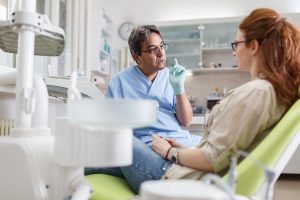
Dental clinicians have been on the front lines of oral cancer prevention and early detection for many years. We have been trained to do very thorough oral cancer exams and to use various light systems to visualize tissue changes; however, according to the Oral Cancer Foundation, the death rate for oral cancers has remained higher than that of many other types of cancers which we hear about routinely.1 Many studies support that the human papilloma virus (HPV) is responsible for a large number of oropharyngeal cancers.
So how do you introduce your patients to the concept of screening for oral HPV? As the treating clinician, you may choose to develop a script, hand out brochures or ask patients to watch educational videos. My approach is simple. I perform an oral cancer exam for every patient. Once I’ve completed the traditional visual and manual extra and intra oral exams, I sit the patient upright in the dental chair to review my findings. I explain that while I see nothing that suggests oral cancer, I can’t see a virus that is known to be the cause of many oral cancers. Due to effective media campaigns in recent years, the vast majority of patients I spoke with knew exactly what virus I’m referring to – HPV. (NOTE: In many practices, patients can be offered an oral screening that includes fluorescence to look for tissue abnormalities.)
Here are 3 typical comments you may receive from patients and how I would respond.
Patient 1: I’ve heard about that HPV virus but I didn’t know you could test for it in the dental office. I’m glad you mentioned it.
Response 1: Yes, we can very easily test for an oral HPV infection using a 30 second saline swish & gargle test to collect a saliva sample. The report will be back in about a week. I can do the test for you right now.
Comment 1: Some patients already have knowledge of the HPV virus and there is typically no need to explain further. You’ve just offered them a very easy way to be screened without having to broach the subject of why or how they may have been exposed.
Patient 2: I’ve heard of that virus but my gynecologist tests me for that.
Response 2: Does your gynecologist collect an oral saliva sample? (In most cases the answer is “no”.) I then like to educate the patient by explaining, that it’s important for them to know that HPV viruses are a skin infection and they don’t migrate from one area of the body to another; however, the same types of HPV that infect the genital areas can infect the mouth and throat. I explain that while the gynecologist screens for an HPV infection of the genital area, in the dental practice we are screening for oral HPV infections. In the case of oral HPV, the vast majority of HPV related cancers are in the oropharyngeal area and base of the tongue area. These areas are nearly impossible to see but an oral saline swish and gargle may detect the presence of the HPV virus in those very areas.
Comment 2: With this knowledge, many patients are receptive to the idea of screening for an oral virus that we can’t see. Again, I haven’t really had to engage in a conversation about anything uncomfortable. I keep the conversation focused on “a virus” or the “HPV virus”.
Patient 3: Tell me more. How do you get this virus? Where does it come from? Do you think I’m at risk?
Response 3: HPV is one of the most common virus groups in the world and is the most common sexually transmitted virus in the United States2; however, there may be other common ways to be exposed. For example, some studies suggest that oral HPV may be transmitted through open-mouthed (“French”) kissing.3 Keep in mind, that all that is needed for HPV transmission is skin-to-skin contact with an area of the body infected with HPV. It is believed that the number of sexual partners is a risk factor for acquiring an oral HPV infection.4 Also; certain individuals may be at higher risk such as a patient with a weakened immune system.
Comment 3: Direct these inquiring patients to the Centers for Disease Control, Oral Cancer Foundation, OralDNA® Labs and American Cancer Society websites for more detailed information.
If you have developed your own verbiage and approach for educating your patients about oral HPV and testing options, I’d love for you to share or comment.
References
- https://oralcancerfoundation.org/facts
- cdc.gov/hpv/parents/questions-answers
- www.verywellhealth.com/does-kissing-lead-to-hpv-transmission-3132987
For more information on how to become an OralDNA Provider – scan HERE: 
- Consumer-Friendly Lab Reports - October 6, 2023
- Microbiology Terminology - March 24, 2023
- Microbiology 101 - January 3, 2020
